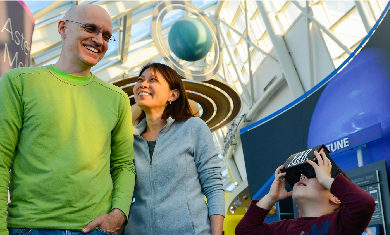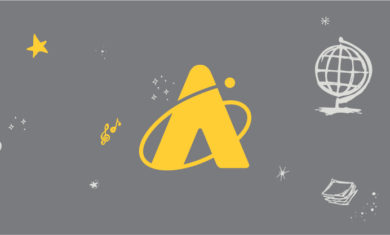Ask Adler Astronomers

You have astronomy questions, and we’ve got answers!
Our astronomers love space science and astronomy questions—that’s why we’re here! Read through frequently asked questions our astronomers receive to see if we’ve already provided an answer to what you’re curious about. We keep this page up-to-date with some of your most burning questions and provide quick, easy answers to get you on your way.
You can submit a question to one of our astronomers by emailing [email protected].
After you submit your question, you can expect a response usually within a week’s time. Our staff is small…but our astronomy answers are mighty! We ask for your patience and understanding if high volumes of emails or busy times of year make response times longer.
Ticketing Or Guest Services Inquiries
We always enjoy hearing from our guests and future guests! If you have questions about Adler Planetarium ticketing, your visit, or any other customer service inquires, please go to Your Visit FAQ page or email [email protected].
Ask Adler Astronomers FAQ
PORTABLE PLANETARIUM
We do not have a portable planetarium, but our people are quite mobile and are out in the community all the time. Check out the rest of our website to see when we will be out in a community near you. Or, come see us here at the Adler; we welcome groups of all sizes.
BUYING A STAR ?
Did you know that names for bright stars have come to us through history from many different cultures and can have various names in different cultures? Dim stars are often named for the sky survey that gathered information about that star, so the same star can have dozens of names although there is no playing favorites as no single name is ever preferred over any other name.
While naming a star might make the perfect gift, the Adler doesn’t endorse or recommend any company that claims to “name” stars. To be honest, if you purchase the right to “name” a star, the company through which you name it is really the only organization that will keep records of your name, so “your” star may also have several different names via several different companies. That said, definitely enjoy having “your” star or naming a star after a loved one, but please know that scientists and backyard observers will not use nor know your star name.
We wish we could! Unfortunately, we’re not able to show you the star for a number of reasons. These stars are usually visible only through a large telescope under a dark sky, and even then, they are quite dim. Sadly, light pollution in Chicago makes viewing these dim stars almost impossible, even with the big telescope in the Adler’s Doane Observatory.
Even if we were able to see the star, there will be many other stars at about the same brightness (or dimness, actually) nearby, making identification of a specific star extremely difficult, and maybe even impossible. An even bigger bummer? “Your” star may be too far south and not even visible from Chicago’s latitude.
The final problem can be simply stated: stars move. When you or someone else “buys” a star, the company you deal with often provides coordinates for the star, listed as RA and Dec. RA refers to right ascension; think of RA as longitude in the sky. Dec refers to declination; think of declination as latitude in the sky. Each star that has been catalogued has a set of right ascension and declination coordinates. But, a star’s RA and Dec coordinates are not fixed for ever and ever. Stars move with respect to our Sun; this is called proper motion. Also, the pointing direction of the Earth’s poles also changes, which separately affects a star’s position in the sky as seen from Earth. Over time, the star’s RA and Dec coordinates will drift. Without the information identifying exactly when those coordinates refer to and what catalog the company used to identify the star, that makes it pretty impossible for anyone to find your exact star.
WHAT WAS THAT?
The answer to this question depends on where you are, what time of day or night you were looking, and what time of year you saw the object. Both Sky and Telescope magazine and Astronomy magazine have digital interactive sky maps on their websites; that would be a good place to start.
The American Meteor Society would love to hear about your sighting. Go to their Fireballs page for more information. You can also report your fireball on their Report a Fireball page. While you’re there, you can see if other people have reported the same fireball! Be sure to check back in a few days, too—more reports may have come in!
More than likely, it was a Chinese lantern. Seriously. We tend to get a few more reports of them when the weather is warm, but we have either seen them in person near the Adler or have heard reports of them at all times of year. Usually, there are several of them launched in sequence, appearing as a string of orange-red lights in the sky moving together in a line. Depending on the wind speed, they may move slowly or quickly. Often, they are launched as part of wedding receptions or other celebrations, so we tend to get reports of them more often on Saturday nights.
WHERE CAN I...?
The Time and Date website is a great resource for this. Put your location into the Sun and Moon page on the Time and Date site, and the information will be calculated for you for sunrise/sunset, moonrise/moonset, and several other interesting pieces of astro data – like moon phases, eclipses, and more!
No, we do not take pictures on every clear night, and are not aware of anyone else who does this on a regular basis, either. There is no central database that exists for night sky or Moon imagery. There are many desktop planetarium programs, such as Stellarium, and phone apps, such as Night Sky for iOS, Sky Safari, or others, that can show you a computer-generated view of what the sky looks like right now or on a given date. The phase of the Moon for a particular date can also be calculated using the Time and Date website.
The National Weather Service has historical weather information on its website.
It is very bright and very easy to see, even under light-polluted skies. It will look like an unblinking airplane. Please visit Heavens Above and/or Spot the Station to find out when it will be visible in your area. If you’ve never seen it; it’s a pretty cool thing to spot.
We also have several online resources that will help you on our blog and our YouTube channel.
The American Meteor Society has a fantastic meteor shower calendar with great information about when to go out to see them. It’s usually best to look for meteors after midnight, with a few exceptions like the Geminid meteor shower in December with meteors appearing as early as about 10 pm on the peak night. Remember, the more light polluted the sky above you is, the fewer meteors you will see, so get out where it is dark!
It’s always best to go far from city lights to see meteors or the Milky Way or any other dim object in the sky– the farther from lights, the better. Light pollution, even just a little, will affect what you can see. Two locations in Illinois that we can recommend that are within a two-hour drive of Chicago are Middle Fork River Forest Preserve in Champaign County, Illinois’ first Dark Sky Park, and Green River State Wildlife Area in northwest Illinois.
Unfortunately, we don’t have an easy answer regarding a darker sky location in the Chicagoland area. Most parks close at or near sunset, though you may want to inquire with the authorities of a particular city to see if sticking around at night might be allowed. Please don’t go onto private land without asking permission of the landowner first. If you are in Chicago or a town near the western shores of Lake Michigan, try to head to the lakefront. The sky out over the lake might be a little darker & this may make it a little easier to see a few meteors, though keep in mind that Chicago Park District parks generally close at 11:00 pm.
In 2021, the International Dark Sky Association designated the Palos Preserves, part of the Forest Preserve District of Cook County, as an Urban Night Sky Place. An Urban Night Sky Place is a location close to a large urban area “whose planning and design actively promote an authentic nighttime experience in the midst of significant artificial light.” The Palos Preserves is currently the largest Urban Night Sky Place in the world. While you won’t see the Milky Way from the Palos Preserves – surrounding light pollution is still pretty bad! – you will experience a setting that helps preserve the darkness in the park area. While most of the forest preserves close at sunset, keep an eye out for specific nighttime astronomy programs on the FPDCC website, or think about booking a camping adventure at Camp Bullfrog Lake, located in the Palos Preserves.
No matter where you are, be careful walking and moving around in the dark! Bundle up & bring some hot cocoa and a lawn chair. Let your eyes adjust to the dark for at least 20 minutes.
Good luck!
This is a really hard question to answer! Aurorae are very hard to predict… sometimes one might not materialize when predicted, or one might suddenly become visible when predictions call for them to appear elsewhere. They could be overhead, or they may just touch the sky toward the northern horizon. They may not appear at all. We also can’t reliably predict them more than a few hours in advance, up to a day or two, at most. The Spaceweather website has the most up to date information about how active our Sun is, when auroras might happen, and what areas on Earth may be likely to see them. A good prediction tool is also the University of Alaska – Fairbanks site. It really helps to be under a dark sky to see an aurora. All our city and suburban lights can drown out a fainter aurora. If you are out to see one, let your eyes adjust to the dark for at least 20 minutes – and be patient. You can see them most often in far northern Canada and Alaska; they happen much less frequently in the Chicago area. Some tour companies even offer aurora viewing trips. Road trip, anyone?
Beginning in March 2022, the Adler Planetarium will be open on Wednesday evenings from 4 pm to 10 pm CT. Adler Planetarium’s Doane Observatory is scheduled to be open during those evenings, but there are a bunch of things that can affect our plans. First, we are at the mercy of the weather. Telescopes can’t see through clouds, and our lakefront site can be fairly cloudy at times. Also, because the time of sunset changes throughout the year, this will affect when – or if – the Observatory can be open, especially in the late spring and summer. A late sunset means it may not be dark enough to see anything before the Adler has to close for the night. And, because many of our telescope and observatory programs rely on the availability of our fabulous telescope volunteers, changes to our Observatory schedule may occur at the last minute and without prior notice. Keep an eye on Adler’s social media accounts (@AdlerPlanet on Twitter and Adler Planetarium on Facebook) for last-minute updates and weather-related schedule changes. We’ll do our best to keep you updated!
The Dearborn Observatory is on the campus of Northwestern University. Look through the historic telescope containing an 18.5″ diameter lens originally made in 1861. Check the website for updates to the hours and dates of operation.
There are lots of amateur astronomy clubs in the Chicagoland area and beyond. Most have meetings where the public can attend, and many offer sky observing programs, either with smaller telescopes or at dedicated observatories. Join a local club and geek out about astronomy as much as we do!
- Chicago Astronomical Society
- Skokie Valley Astronomers
- Lake County Astronomical Society
- Northwest Suburban Astronomers
- Fox Valley Astronomical Society
- Naperville Astronomical Association
- Calumet Astronomical Society
- Kankakee Area Stargazers
- Astronomy clubs in Wisconsin
- Astronomy clubs in Indiana
- Astronomy clubs in Illinois
- Astronomy clubs in Michigan
WHEN IS...?
Daylight Saving Time in the U.S. is currently the third Sunday in March to the second Sunday in November. Other countries have other time periods for Daylight Saving Time—or they do not utilize DST at all.
Please note that Daylight Saving Time has not always been during this exact time period and the specific date(s) that Daylight Saving Time started in the United States will be different from when Daylight Saving Time started in other countries, so if you are looking for whether a specific date in history incorporated Daylight Saving Time, we suggest starting with this resource from Time and Date.
Visit the Time and Date website for more information.
WHAT MIGHT THIS BE?
Please do not bring your specimen to Adler, do not send your specimen to us (we won’t return it), and please do not send a picture. It’s truly impossible for anyone—even a professional who studies meteorites—to conclusively identify anything as a meteorite purely by sight or via a picture. We also don’t have the proper equipment or instruments here at the Adler to study specimens and identify them as meteorites.
There are many unusual Earth rocks and man-made materials that are often misinterpreted as meteorites, such as slag from factories, asphalt, and concrete chunks. Web pages at Washington University in St. Louis and The University of New Mexico may help you begin to determine if your rock is or is not a meteorite. We’d advise you to start your search for information on both of these sites. The Washington University site also includes information from Dr. Randy Korotev about how to get a rock tested and certified (please note: the process can be very expensive).
Pretty exciting stuff, right?! We’re more than happy to review your picture to see if we can figure out what you saw. We can accept images in the following formats: JPEG or JPG, PNG, TIFF; your image should be 5 MB in size or smaller.
Before you send it to us, though, please check to make sure what you photographed isn’t a lens flare. Here are some examples of what those flares might look like. Lens flares are due to internal reflections of light inside a camera’s optics. Sadly, many of the images we receive are of lens flares. If you’re convinced that your image is not of a lens flare and you would like us to review it, please email it to us at: [email protected].
CAN I SELL/DONATE/HAVE SOMETHING APPRAISED?
Thank you for thinking of the Adler Planetarium as the future home of your meteorite! While we can’t recommend specific meteorite dealers, and we generally don’t purchase them, if you would like us to consider accepting your meteorite as a donation to the museum, please send a letter with any relevant imagery and certification documentation, along with your contact information, to Curator, Adler Planetarium, 1300 S. Lake Shore Dr., Chicago, IL, 60605. Our Webster Institute staff will contact you if they feel that the item might be considered for our collection. Please note that requests will only be considered if the meteorite you’re offering has been identified by a laboratory or a professional scientist who specializes in meteorite identification. We also ask that you not send or bring the meteorite to us without prior approval from our curatorial staff; that could get pretty awkward.
You’re too kind! We appreciate that you would consider the Adler as the appropriate place for your historical item. If you would like an item to be considered for donation to the Adler, please send a letter describing the item with any relevant documentation and images, along with your contact information, to Curator, Adler Planetarium, 1300 S. Lake Shore Dr., Chicago, IL, 60605. Our Webster Institute staff will get in touch with you if they feel that the item might be considered for our collection. Please do not send or bring any items to us without prior approval from our curatorial staff; see above; that could get awkward.
It’s a bummer, but unfortunately, we can’t. Museum staff aren’t ethically permitted to appraise the value of objects related to their collections. The potential for conflict of interest is too great. Think of it this way: A curator might be tempted to appraise an object at a high value, so that its owner could take a large tax deduction for donating the object to the curator’s collection.
To get an appraisal, you need a specialist who knows the field, but who is not at a museum. A good appraiser is usually someone who buys and sells the type of object in question. For example, astrolabes are best appraised by dealers who buy and sell astrolabes. Maps are best appraised by dealers who buy and sell maps. The more specialized the dealer’s knowledge, the more accurate the estimate of the object’s value.
Keep in mind that a dealer has at least as much potential for conflict of interest as a curator, and both parties should be aware of the potential for conflict of interest. If you can’t find a dealer who specializes in your type of object, there are many professional appraisers with wide expertise and experience. Try calling the American Society of Appraisers (1-800-ASA-VALU) or visit http://www.appraisers.org.
Thank you for thinking of us! No, we do not accept telescopes for donation. We already have an extensive collection of telescopes that we use for educational purposes. Please consider getting in touch with a school in your area that may have an astronomy club or a STEM or STEAM Lab/Club. They may be able to put your telescope to use.
TELESCOPE SHOPPING?
Head on over to the Adler’s Telescope Observing webpage and scroll down to the “Telescopes: What am I Looking For? Where Do I But One?” section for some suggestions!
CAN WE CHAT?
If you are a media representative (radio, TV, print), please visit the Adler’s Press Room.
If you are a student requesting an interview, unfortunately, we cannot accommodate any interview requests. The number of astronomers we have on our staff is very small, and we just can’t handle the volume of requests we receive.
The American Astronomical Society has a web page and a downloadable PDF with a lot of information for students wishing to learn about astronomy as a career.








